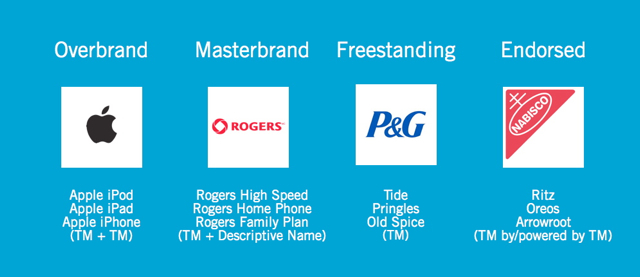[UPDATE: THE BEST PRACTICES IN WHAT IS BRAND ARCHITECTURE CAN NOW BE FOUND IN OUR FREE BRAND ARCHITECTURE EBOOK, HOW TO ORGANIZE YOUR BRANDS. DOWNLOAD IT TODAY.]
Architecture is the planned design of a system. It could be the planned design of a building, a piece of software, the flow of information, or an object.
Brand architecture is not your brand strategy, your brand systems (logo, slogans, tag-lines and visual imagery) or your brand marketing plan. It is a higher-level plan of your brand ecosystem, so you can determine how to best build and scale your brand over time. Specifically, it sets out your plan to build one brand or multiple brands. And, if multiple brands, what will be the relationship between them? Child? Parent? Sister? Stranger?
Four Brand Architecture Options
- Sub-Brands — There is one corporate trademark and sub-brand trademarks. For example: Apple iPad.
- Masterbrand — There is only one trademark and then descriptive names. For example: Rogers Home Phone or AT&T Device Protection & Control.
- Freestanding Brands — There are many brands, speaking to many different audiences designed to stand apart. For example: Pringles, Old Spice, Luvs Diapers, Gillette are all freestanding brands of Proctor & Gamble.
- Endorser Brand — There are product brands linked together by an endorsing brand. For example: Oreo Cookies by Nabisco
Brand awareness suffers without a quality brand architecture. The figure below provides examples of each type of brand architecture. We will go into the details of each type in upcoming posts.
The Top Three Mistakes
- Over branding – Dividing the attention of the audience by creating or maintaining too many brand names, logos, and messages when one will suffice.
- Misbranding – Confusing customers by applying an existing brand to a new product with a very different audience.
- Cannibalization – Losing high margin customers by introducing a disruptive new brand, which is targeted at the same customer need and is associated with your premium brand.
The Hallmarks of Good Brand Architecture re Simplicity, Scalability and Commitment
- Simplicity – It is easy for the customer and your team to understand.
- Scalability – The way that you unify or introduce brands leaves you room to grow, rather then painting you into a corner down the road.
- Commitment – As with all successful branding efforts, the team must be committed to the architecture and must not break your brand architecture rules for vanity projects.


